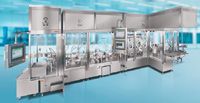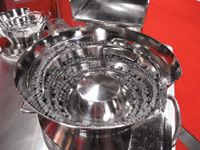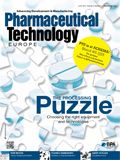New Technologies Displayed at INTERPHEX
Pharmaceutical Technology Europe
Our Packaging Forum editor reports on the infamous US trade show, INTERPHEX. Highlights included the latest in pharmaceutical packaging equipment, containers and labels, as well as new capabilities among contract service providers.
INTERPHEX never disappoints. Whatever packaging solution is needed can be found on the show floor. Highlights of the 2012 event, which took place 1–3 May at New York City's Javits Center, included a container-making alternative to injection moulding, versatile vial fillers and other equipment for the packaging line, expanded service offerings, new carton and label concepts, cold-chain support, integrated serialization systems, and quality control innovations.

Hallie Forcinio
Innovative containers
A hybrid forming technology has advantages over traditional injection moulding. The marriage of compression forming and blow moulding generates less waste, shortens cycle time and requires less energy and heat, largely because no manifold is needed to distribute molten resin to individual cavities. A 12-station, rotary machine extrudes and cuts molten high-density polyethylene and transfers the shot into a compression cavity for a subsequent two-stage blowing process. Container sizes range from 60–300 mL. Eliminating station-to-station indexing shortens cycle time. The absence of a manifold for melt distribution prevents temperature variations and lessens chances of flaws from resin burn and degradation. An extremely consistent wall thickness offers the potential for lightweighting. The machine also integrates three levels of quality control: leak detection, infrared inspection for surface and embedded particulates, and plasma surface treatment to improve label adhesion. A 20-station machine, currently under development, will require only minor adjustments to change from high-density polyethylene to polystyrene, polypropylene, or polyethylene terephthalate (Compression blow-formed containers, Amcor Rigid Plastics; compression blow-forming machines, Sacmi Group).
Chemical tempering after the forming process strengthens glass cartridges used in autoinjectors and pen systems. A molten potassium nitrate bath replaces sodium ions in the glass with larger potassium ions and results in a denser surface. It also increases the surface compression and reduces stress created by miniscule flaws in the tubular glass, which cannot be seen by the naked eye but are always present (tempered glass cartridges, Gerresheimer AG).
Cartons and labels
With requirements for Braille labelling likely to expand, a fourth-generation, family-owned carton converter was on display that is prepared to emboss and verify the tactile code on its folding cartons. A high-speed camera system checks the depth and accuracy of each embossed dot at production speeds and rejects any faulty cartons. The Braille embosser and inspection system are installed on the folder-gluer and are an alternative to a more complex system and expensive die-cutter-mounted system (AccuBraille embossing system from Bobst and BrailleChek system from Valco Melton, installed at Ingersoll Paper Box Co.).
Digital, flexographic, and offset printing address low, medium and high-volume folding carton runs with virtually no variation in print quality. The printer also offers services to reduce carton costs by consolidating sizes and stock-keeping units (SKU Consolidation and Right-Sizing services, Innomark Packaging Solutions).
New label concepts include a design to impart child resistance to blister cards. The multilayer, pressuresensitive label provides six barriers to entry—three logical and three physical. In use, the first step is to peel off the top layer to reveal a series of pictograms, which provide instructions for access (CRSF label, Faubel Pharma Services).

Gerresheimer’s glass-tempering technology strengthens glass cartridges.
A 48-page booklet label marries insert and primary label to cut costs and simplify inventory, ordering, quality control and packaging-line changeover. Also available in a ribbon style, the insert/label combo is integrated as the label is flexographically printed. Barcodes on each component prevent mix-ups (booklet label, Platinum Press).

Bosch Packaging’s fully integrated FXS line fills presterilised syringes.
Special adhesive and die cutting produce a pressure-sensitive label that applies smoothly to the narrow circumference of autoinjectors. Options include embossed bumps that could carry a Braille message, but are primarily intended to prevent the pen from slipping during use. Labels also may incorporate colourshifting ink for anticounterfeiting protection or thermochromic ink that shows when a product has reached the correct dispensing temperature. In pens designed for multiple doses, multiply structures permit reverse printing that preserves the readability of any messages or instructions despite repeated handling. A peelable layer allows users to check product level through a window, but otherwise blocks transmission of ultraviolet light (Pen Label, Schreiner MediPharm).
Contract services
Contract manufacturers and packagers are investing in their operations to meet rising demand. Several firms have added capacity for filling solid dosage forms in bottles (A+ Secure Packaging, Almac, Pharma Packaging Solutions, Reed-Lane).
Contact manufacturers have also invested in new lines dedicated to blister packaging. One blister line integrates blister foil printing, checkweighing and vision inspection. The 200-per-minute line handles a range of materials, including polyvinyl chloride (PVC), PVC/polyvinylidene chloride, Aclar, and aluminum/aluminum (UPS 4 blister line from Uhlmann, installed at Almac).
A UK-based specialist in clinical trials and small batches has installed an aseptic vial line for small-volume parenterals. The line primarily fills volumes ranging from 2–20 mL, but could handle vials up to 100 mL (SCM Pharma).
A year-old stick-packaging line forms, fills and seals 400 mg to 3 g of moisture-sensitive pharmaceuticals and probiotics in narrow, foillaminate packs. Especially wellsuited to products for paediatric and geriatric populations that are intended to be mixed with food, the fully integrated line operates in a humidity- and temperature-controlled environment. Rated at 1000 packs per minute, the line doses 10 packs at a time and loads finished packs into 7-, 14-, 28- or 56-count cartons (Stick-pack contract packaging service, Ropack).
An on-site, visual inspection service provides equipment, certified technicians and service without the capital investment, integration, maintenance and training issues associated with purchasing equipment. With several models available, equipment can be matched to the application and installed in line or as a standalone unit. Scalable contracts adjust to changes in usage (contract inspection service utilising Viswill (formerly Kanebo) equipment, Visionspect Division of Daiichi Jitsugyo Viswill).
Aseptic filling
A fully integrated filling line for presterilised syringes starts with automatic bag and tub openers and features an integrated checkweigher. A combi-filling station accommodates traditional or single-use product paths as well as rolling diaphragm or peristaltic pumps (FXS line, Bosch Packaging, shown running syringes from Schott North America and stoppers from West Pharmaceutical Services).
A servo-driven, double-tool, rotary filler/capper indexes two containers at a time to handle up to 70 containers per min. Container size changes require removal and installation of the appropriate dedicated starwheel. Height adjustment is automated. The machine is typically integrated with a rotary table at the infeed and a label applicator and accumulation table at the outfeed (3020 DT monoblock, M&O Perry Industries).
A compact system designed for Class 100 cleanrooms features a peristaltic pump and single-use product path. Available with two, four, six or eight filling heads, the servodriven unit automates both container height and nozzle stroke adjustments. The filler handles container diameters ranging from 16 to 76 mm (⅝ to 3 in) at up to 30 cycles per min. Maximum container height is 203mm (8 in) (VR2PP series liquid filling machine, Cozzoli Machine Co.).
Peristaltic and rotary piston pump options are available on a higherspeed filling/stoppering machine capable of handling 100 vials per min. Tool-less changeover adjusts the unit for vial sizes from 2–100 mL. The system integrates with vial washing, sterilising/depyrogenation tunnel, capping and tray-loading equipment, as well as a Class A restricted access barrier system. Options include pre- and post-fill gas flushing, in-line process control, automatic fill adjustment and automatic vial reject (FS-22 Filling/Stopper Inserting Machine, PennTech Machinery Corp.).
A vial filler/capper provides feedback statistics on machine performance including applied torque. The serialisation-ready system tares bottles before filling, checkweighs and applies stoppers and caps. Pumps are matched to product characteristics (Bambino vial filler, Capmatic).

Cozzoli’s VR2PP aseptic filler with single-use product path is designed for Class 100 cleanrooms.
A servo-driven benchtop system, equipped with a peristaltic pump and single-use product path or rotary piston pump, fills and applies stoppers to presterilised nested vials (2–20 mL) or Hypac syringes (0.5–20 mL). Bottom-up filling with vacuum seal prevents air bubbles in the product. The stoppering function also depends on vacuum. Programmable logic controller automates all operations except placement and removal of the nest of containers (FSM modular syringe and vial filling system, Colanar)

QS Systems bowl feeders from Service Engineering feature quick-connect latches and simple lift-off components.
Another tabletop system fills infusion bags. The semiautomatic machine requires manual feeding of the bags and sealing caps and is capable of filling about eight, 500-mL bags per min. Other bag sizes include 50, 100, 250 and 1000 mL (Plümatex-BFM 007-SFC Filling and Sealing Machine, Plümat North America).
A variety of bag structures are available for infusions and other intravenous products. Three-layer coextruded polypropylene bags with a highly inert, weldable inner layer protect sensitive products and can be produced in a variety of single- and multichamber styles with various ports and connectors (Inerta bags, Technoflex). For products that must be frozen or for cryogenic stem cell preservation, bags, tubing and connectors are made of a material capable of withstanding temperatures from -10 to -196 °C (Ethylene vinyl acetate bag, tubing, and connectors, Technoflex).
A three-dimensional (3D) video based on CAD drawings of equipment provides a virtual look at how various fillers and integrated machines work. Although currently used as a marketing tool to showcase turnkey line capabilities, the 3D technology has potential as a training aid (interactive 3D virtual tour, Optima pharma).
Other equipment
A versatile, servo-driven blister packager thermoforms or coldforms blisters up to 40 mm deep and features tool-less changeover. An integrated print station prints on the top or bottom of the lidstock depending on how the material is threaded. An autolift mechanism protects heat-sensitive products by raising the seal station if the machine stops (BP540 blister machine, Pentapack NA).
Bowl feeders for stoppers and other small parts change over without tools, thus reducing downtime from 10–30 min to less than 1 min. Patent-pending units simply unlatch and lift off; the unlatching/latching mechanism can be automated (QS Systems bowl feeders, Service Engineering).
Dots of an instant-bonding, pressure-sensitive adhesive are dispensed from a paper carrier web to provide a competitively priced alternative to hot melt for sealing folding cartons or attaching inserts/outserts to packaging. Eliminating hot melt reduces waste, clean-up tasks, warm-up time and burn hazards. Once adhered, the FDA-compliant pressure-sensitive adhesive peels cleanly with no fibre tear or residual staining, thus making it wellsuited for use with inserts or other materials where print must remain undamaged. A video trial programme allows prospective purchasers to see how the automated applicator works for their application before they buy a system (SD-900 applicator for Glue Dots brand adhesive, Glue Dots International).
A lab-scale unit punches and seals lidstock to unit-dose containers. The tabletop, servo-driven machine monitors force, time and temperature and handles either peelable or nonpeelable lidstock (RD 06 punching and sealing machine, Rychiger US).
Packagers who need containment or an aseptic filling environment can retrofit a flexible isolator with clear polyurethane or PVC walls that allow operators more freedom of movement than rigid counterparts. Systems are compatible with negative air pressure or nitrogen atmospheres. Single-use systems eliminate much of the cleaning and validation required with conventional rigid isolators (Ace flexible wall isolators, Telstar North America).
An inkjet printer handles print widths from 108 to 540 mm (4.26 to 21.26 in.) at speeds of up to 100 m (328 ft) per min. Ultraviolet ink dries instantly and doesn't absorb or bleed to produce crisp alphanumeric characters as small as 4-point. Designed for mounting on horizontal form-fill-seal, blister and flow pack machines, the digital coder also reproduces serialized numbers, one and two-dimensional barcodes, and graphics at a resolution of 600 dpi (InteliJet HD inkjet printer, Bell-Mark Corp.).
INTERPHEX returns to New York's Javits Center April 23–25, 2013.
Hallie Forcinio is Packaging Forum editor editorhal@cs.com.

Transformations in Drug Development for Cell and Gene Therapies
March 28th 2025As a recognized leader in immunophenotyping for clinical trials, Kevin Lang from PPD discusses how spectral flow cytometry is transforming drug development, particularly in cell and gene therapies like CAR-T. He also dives into his award-winning research, including his 2024 WRIB Poster Award-winning work, and his insights from presenting at AAPS PharmSci360.
Advancing Clinical Trials with Spectral Flow Cytometry: A Conversation with Kevin Lang
March 28th 2025As a recognized leader in immunophenotyping for clinical trials, Kevin Lang from PPD discusses how spectral flow cytometry is transforming drug development, particularly in cell and gene therapies like CAR-T. He also dives into his award-winning research, including his 2024 WRIB Poster Award-winning work, and his insights from presenting at AAPS PharmSci360.
Pharmaceutical Tariffs Are Imminent: How Industry is Bracing for Impact
April 16th 2025On April 14, 2025, the Trump Administration launched a national security-driven investigation into pharmaceuticals, a move that will likely result in tariffs being placed on pharmaceutical drugs, ingredients, and other components that are imported from outside of the United States.